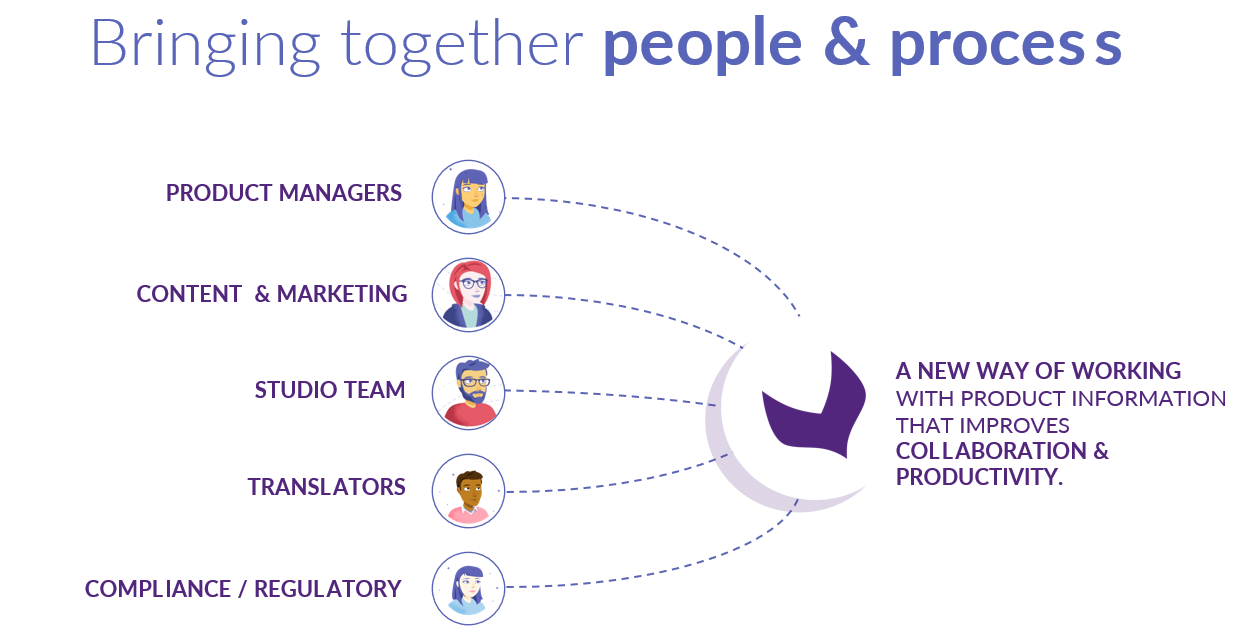So when I opened a PIM for the first time, I have to admit that I did not get it immediately. I had never worked directly in the eCommerce industry (and the eCommerce team is rarely involved in an ERP implementation). What I could see on my screen was a lot of product edit forms! Which makes total sense, as the main goal of a PIM is to enrich product information and improve its quality. But at first, the scope seemed so small to me.
After discovering all the features though, I totally got it. I just loved the marketing and customer-oriented approach. I was so ready to go onsite to work with many new colleagues: the eCommerce team, merchandising team, content team, studio team, and print catalog team. For me it was now super clear - ERP does support the supply chain and internal vision of the product, the PIM, the market, and the end consumer.
As an experienced consultant, I spent my time listening to these people. One day during one particular project for a mass-market fashion brand, a young well-styled man interrupted one of our workshops to ask the Product Manager if the product he was about to showcase on their Instagram account was the right style, meaning
the right color, and to make sure the product had not changed since the sample validation step. We know the impact it has on sales, so you can’t get this one wrong.
At the time we were implementing a PIM to support an eCommerce platform migration for this fashion brand. So the project was 100% focused on the eCommerce part. But from that exact moment when the community manager with great fashion sense interrupted the workshop, I understood that
a PIM project is much more than implementing another tool to only support one channel. It is about offering a new way of working for all the business users in a company.
This community manager-turned-social-seller could have easily and quickly found this information in the PIM. Everywhere you sell and market products, there must be a PIM that
establishes a strong foundation of your product data, that is always clean and available to share with all the touchpoints you have with your customers. Not just your social networks like this community manager asked about, but also your physical stores, the digital screens in-store, the sales app, the marketplaces you sell on, and yes, your own website(s).
From an eCommerce-oriented PIM to a channel-agnostic one
As soon as I understood the benefits of implementing a PIM, I started to re-think the workshops we delivered, and about the attendees of these sessions. But this implied challenging the project scope for each customer and making them understand how more teams could benefit from this new tool, and how it could solve a lot of product enrichment issues.
Don’t get me wrong, it was not about questioning their strategy, but more about broadening the scope, opening this new goldmine to anyone dealing with or consuming product information.
Behind each of your sales touchpoints, there is a team, or at least a human. And these people need to be empowered to understand that
they won’t work in silos anymore but will work to support their company strategy, all collaborating with one single source of truth for their product information.
So how did I learn to get buy-in and make a PIM project a success that involved everyone? How did I engage them in such a project? Basically, by rallying the troops! For the first workshop at one client, we advised our customer to invite all the people in the company that either enrich, contribute, or even just consume product information - which could lead to having over 30 people in the room at once. Yikes!
The main goal we had was to make sure that:
- Everyone was aware of this new tool in the company.
- Everybody got the same level of knowledge: what is the PIM scope? How does it work with other systems already used (PLM, ERP mainly)? What does it mean for everyone’s daily work? It’s not about duplicating work or working for others… but about building a strong, healthy, common foundation to support the company's growth.
- Everybody understood how they could benefit from this new tool: fewer informal requests, less manual (re)work, fewer e-mails, better relationships, smoother enrichment, and more digital processes.
After making sure all the teams were engaged and successfully able to create this smooth enrichment process, we needed to understand who is responsible for which piece of product information, and who depends on others for information.
And we had to get answers to many specific questions: How do you create a product? Is a product a sample beforehand? Is it possible to start writing a description without at least a picture of the product? How is the assortment managed? Is a product available by default for all the markets you address, or do you have an assortment of products by market? Is there a team responsible for validating all the product information? Who makes sure it complies with market regulations? Who decides that a product is ready to be seen by and sold to end consumers?

At the end of the workshops, any stakeholders connecting to the PIM could understand what they had to do, and how to do this, without any additional training because everything would have been designed according to their way of working and their specific needs: from their workspace just showing the products they have to work on, to the language(s) they have to create content for, to the product information they are responsible for. Ultimately, these people immediately adopted both the technology and the processes to help them, changing the way they worked for the better.
From a PIM to a PXM Studio
Feeling more than ready after this early customer, I was now mature enough to work with all kinds of companies with their different business challenges. Once the teams started to understand the power of collaboration and had product information ready for any new business challenge, they started thinking about
broadening the scope of their collaboration with their external providers. For resellers, instead of receiving and dealing with a lot of different formats and spreadsheets, we started to think about making onboarding product data easier and faster. That’s precisely how
Akeneo Onboarder was born, by the way! The same goes for the manufacturers I worked with. How could they share accurate information with their business partners, resellers, and marketplaces? Et voilà!
Akeneo Shared Catalogs joined the family.
The magic really started to happen for me when some companies heard about Akeneo and decided they, too, needed a PIM after some of their business partners mentioned they were saving time, rationalizing processes, and sharing better product data quality with this new way of working. A lot of Akeneo customers work with other Akeneo customers: in the fashion industry, in cosmetics, in the B2B world, with specialized distributors. So many businesses in these areas are connected to or collaborate with others in one way or another. It is so great to connect people together, simplify their daily life, while all speaking the same language.
One of the recurring questions I received from my customers during this time was “
How long will the project last?” I have now a clear and irrevocable answer: “
The project timing will only depend on how mature and ready you are with your product data dictionary and with your product enrichment lifecycle.” If a company is clear on what a product is for them, then what their customers need to know about their products and their brand becomes much clearer too. And if every team knows which product information they are responsible for to make it the best it can be, and how doing so can address their business objectives, then they are well on their way to growth, success, and maturity.
And this part of my story brings me to what Product Experience Management (or PXM) is all about. It’s how you can make sure your people, your processes, and your technology are orchestrated to efficiently deliver high-quality product information in the right context, adapted to the sales touchpoints and markets you address, all aligned with your business strategy.
So that’s my journey of maturity in the world of PIM and PXM. How about you? If you’re wondering where you are on this path,
go answer these 14 short questions to receive a personalized report with actionable insights all based on my 6 years of experience with discovering and building your peers’ maturity. I look forward to learning where you are on your journey!




